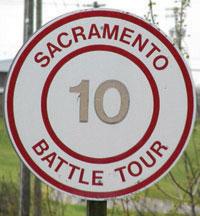
This tour will allow you to retrace the course of the Battle of Sacramento and learn about the people involved in it.
You can begin the tour at any point, but it will work best if you begin either at (1) Greenville or (10) Calhoun. Look for the red and white tour signs.
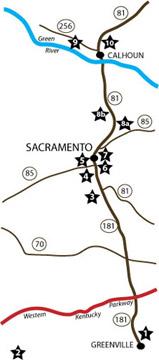
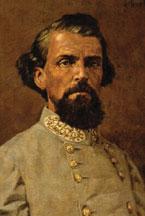
Confederate forces, under Lt. Col. Nathan Bedford Forrest, were active in the Green River area during the fall and winter of 1861.
They were protecting the Confederate base and capital at Bowling Green and trying to maintain control of the Green River and the surrounding area, a long time source of food for the lower South.
Ten thousand Union soldiers under General Thomas Crittenden were stationed in Calhoun protecting Lock and Dam No. 2 and maintaining the security of the Union’s Ohio River supply lines as the campaign for control of the Mississippi was developing.
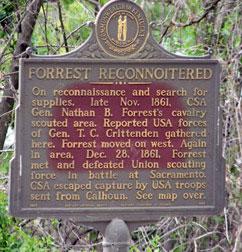
Control of the Green River was crucial to both Union and Confederate goals during the maneuvering for position in late 1861. This made McLean County a focal point for both sides.
On Dec. 27, 1861, Forrest assembled a force of some 300 men in Greenville to scout Union positions in the farming country between there and Calhoun.
Union Major Eli Murray, only 18 years old, led a scouting party out of Calhoun to reconnoiter the area around Sacramento. The two forces collided on December 28, with Forrest emerging the victor, in what came to be known as the Battle of Sacramento. The Union forces reported 11 killed and 40 missing, while Forrest lost only 2 men.
Confederate success was fleeting, however, and by February, they had withdrawn from Bowling Green and conceded control of the Green River valley to the Union - losing access to one of the South’s traditional sources of food.
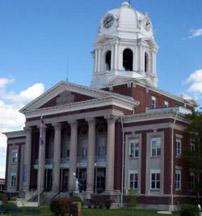
1. Greenville/Muhlenberg County Courthouse. (left-present day courthouse)
On December 27, 1861, Forrest assembled his forces at the courthouse in Greenville, the county seat of Muhlenberg County. Forrest gathered nearly 300 men for a march toward Rumsey the following day. In Greenville, Forrest was joined by Captain W.S. McLemore’s 40 man unit, James W. Starnes’ Eighth Tennessee Cavalry and Captain Ned Merriweather’s First Kentucky Cavalry. That night Adam R. Johnson and Robert Martin were sent to scout the area for Union forces that might have crossed the Green River.
The morning of the 28th, Forrest’s troops rose early and obtained breakfast and lunch for their carry sacks at the farm of a Southern sympathizer just north of Greenville. Forrest moved his men north toward Rumsey where they met Martin and Johnson eight miles outside of Greenville. The scouts reported sighting a Union force just south of Sacramento. Forrest pressed his forces quickly toward the small village of Sacramento, located nine miles south of Calhoun,. Kentucky Historical Society Marker 614.
2. South Carrollton Site - Under Development
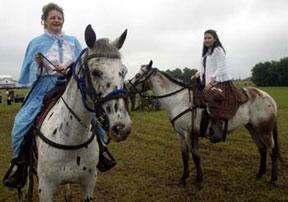
3. Kentucky 81 and 181.
Near here, Forrest and his troops met scouts Adam Johnson and Robert Martin. They warned Forrest of the Union troops in Sacramento. Forrest hurried to Sacramento to engage the Union troops before they moved on - displaying what became his characteristic aggressiveness. Closer to Sacramento he met Molly Morehead, who gave him more precise information about the Union troops.
(Left -Morehead Reenactor)
4. Garst's Pond.
Part of Major Eli Murray’s scouting party was watering their horses at Garst’s Pond when they were spotted by Forrest and his advance party. The two groups made visual contact and initially the Union troops were unsure whether Forrest’s men were Confederates or another Union scouting party. Any doubt was resolved when Forrest grabbed a rifle and fired at the Union troops. The Union soldiers returned fire, mounted and rode quickly to rejoin their military force. Garst’s Pond is 2.3 miles north of the intersection of 81 and 181.
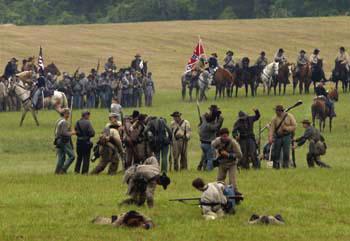
5. Sacramento Battlefield.
The Union rear guard returned immediately to its main force. Forrest began his attack without his full force, part of whom were still catching up after the pressed advance. Federal forces fired at 200 yards and Confederate troops returned fire at 80 yards.
Realizing his disorganization, Forrest pulled his forces back, waiting until all his men caught up with the main force. At the same time, he dismounted some of his men to act as sharp-shooters.
Next, he sent detachments under Major D.C. Kelly to the Union right and James W. Starnes to the Union left.
Mistaking Forrest’s withdrawal as a retreat, Murray began to advance his outnumbered force. With the reorganization of his entire force complete, Forrest began 2nd attack on the Union center at the same time, Kelly and Starnes attacked the Union flanks.
During the charge on the Union center, Captain Ned Merriweather fell as he was struck by two bullets in the head. Murray’s troops held off the Confederate attack for ten minutes. Optimistic about their ability to withstand further attacks, the Union commander later reported that the Union force was doing well until a young private screamed “Retreat to Sacramento”. The Union troops turned and ran toward Sacramento despite their officers’ attempts to stop them.
Kentucky Historical Society Marker 523. The original battlefield is listed on the National Register of Historic Places.
6. Village of Sacramento.
Sacramento was not a safe haven, as Southern sympathizers in the village fired on the Union soldiers from their businssess and homes. In Sacramento, Forrest’s men caught up with a Union rear guard, resulting in a great deal of hand-to-hand combat, including various saber fights. Proceed north on 81 through Sacramento.
7. Sacramento Cumberland Presbyterian Church Cemetery - Molly Morehead's Grave.
Mary (Molly) Morehead was the 18 yr. old daughter of Hugh Morehead. She and her sister, Sarah, were on an errand when they observed Union troops near Garst’s Pond. While Sarah rode to tell their father, Molly rode toward Greenville to alert the Confederate troops. Forrest recounted that “a beautiful young lady, smiling with untied tresses floating in the breeze on horseback, met the column just before our advance guard came up on the rear of the enemy, infusing nerve into my arms and kindling knightly chivalry within my heart.”
Her name, not in Forrest’s report, was unknown until Molly’s story, preserved through family history, was published in a 1962 McLean County News article. Molly married Dr. George Stowers, a dentist in 1866 and died during childbirth in 1870. The cemetery is on the east side of the highway, north of the Methodist Church. Molly’s grave is on the northeast section of the cemetery.
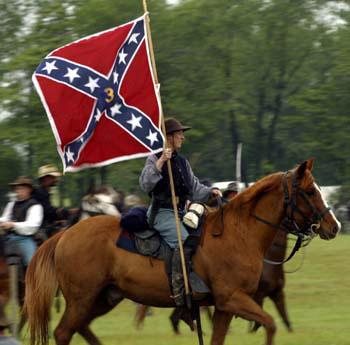
8a. Present Day Station Baptist Church
8b. Original Church Location - Site of the Saber Battle
In the midst of the chase Forrest was engaged in hand-to-hand combat with a Union soldier. He was unaware of a second soldier approaching him from the rear. CSA Lt. Lane shot the second attacker just as Forrest brought his foe to the ground. Union Captain Arthur Davis killed Confederate Private William H. Terry with his sword. Fortunately for Forrest, Davis’ horse fell, dismounting him and dislocating his shoulder. Davis was forced to surrender. Another Union Captain, Albert G. Bacon, next engaged Forrest, but his shots narrowly missed. Forrest turned and returned fire, wounding Bacon, who refused to surrender and fought to his death. Two Union officers charged at Forrest with drawn sabers at the same time. He shot one and hit the other with his sword. Their now riderless horses collided into a heap at the bottom of an “abrupt hillock”. In pursuit of the retreating Union troops Forrest rode into the pile of men and horses and ended up off his own horse.
The pursuit of the Union troops had extended some two miles north of Sacramento toward Calhoun. By the time Forrest was back on his horse, the Union troops were out of sight and close to the larger force in Calhoun. He decided to abandon pursuit and return to Greenville.
As soon as he heard of the engagement, Crittenden sent a 500 man relief force under Col. James Jackson of the Third Kentucky Cavalry. However, by the time they arrived in the area. Forrest was gone, well on his way back to Greenville. The 1861 Station Baptist Church was approx. 4 miles north of Sacramento on the east side of Hwy 81. The present day church is 5.1 mi north of Sacramento on the west side.
9. Calhoun - Lock & Dam #2.
Union troops were set to Calhoun to protect the original lock and dam which was located across the river on the Rumsey side. The Green River locks and dams promoted navigation and allowed the region around the river to become a major source of food for the lower South as it became more involved in growing cotton. These same locks and dams allowed the Union army to move men and supplies along the river. Go across the Green River on Hwy 81 around the curve to the stop sign. Turn right onto KY 256 to the Lock and Dam.
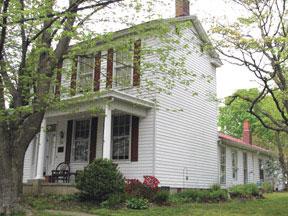
10. Griffith-Franklin House - Crittenden's Headquarters.
Union commander Thomas L. Crittenden made this house his headquarters when he arrived to protect the Lock and Dam Number 2 in November 1861. The house was built in 1854, by the heirs of John Calhoun, for whom the city is named. It was purchased by W.W. Frankling in 1859.
On February 9, 1862, Crittenden and his troops left the area. This house was listed on the National Register of Historic Places in 1975. Lcoated at 390 Second Street, corner of Poplar in Calhoun. Kentucky Historic Society Marker 665.
More information about the McLean County Civil War Sites Driving Tour
